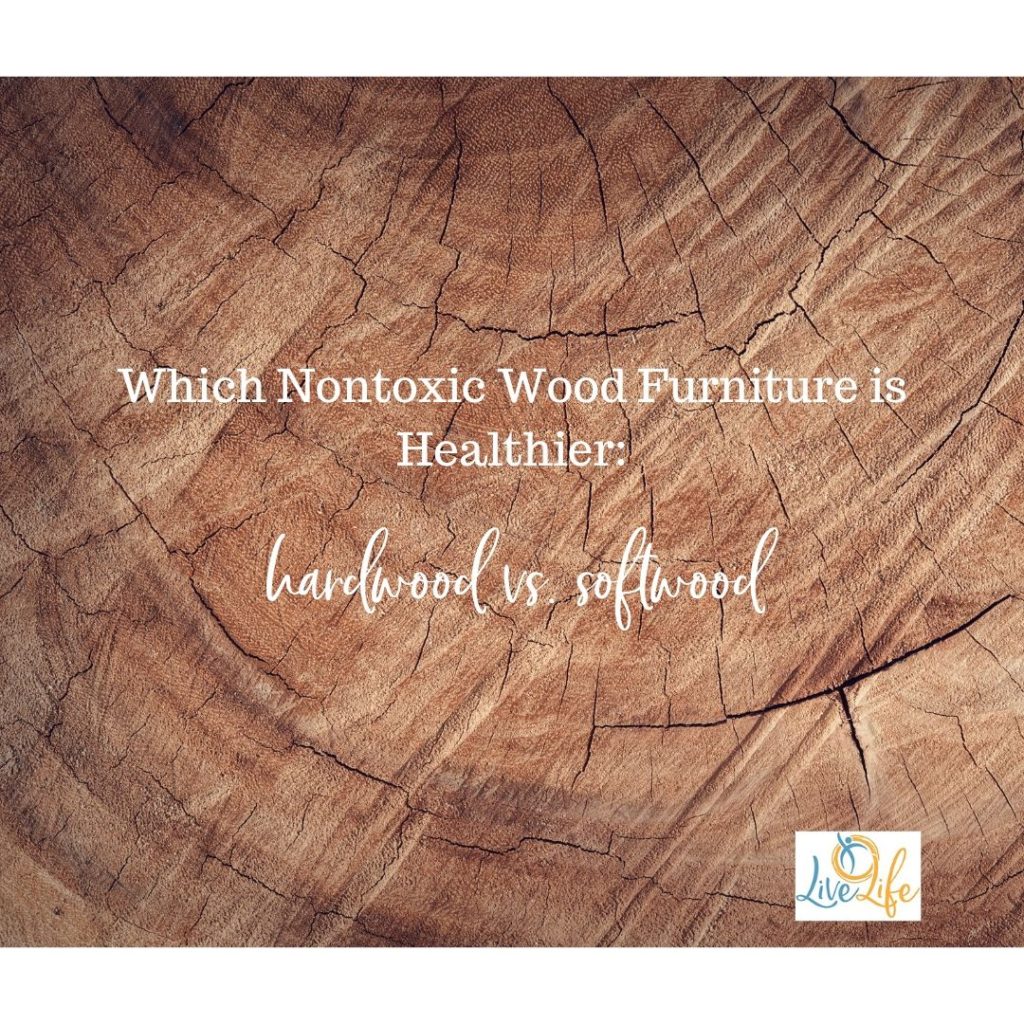Are you buying nontoxic wood furniture for the bedroom, kitchen, or living room and want to consider all of the factors for choosing organic, nontoxic furniture?
Wood type is one of four factors you should consider.
Why?

Woods, by nature, off-gas volatile organic compounds (VOCs) into the air.
Therefore, when choosing your organic wood furniture, you’ll want to choose a nontoxic wood type.
In this article, we’ll discuss the importance of choosing the right wood type, the two types of natural wood, and which is healthier for your home.
Why is Wood Species Important to Consider?
So many people (!) think that only human-made materials produce VOCs, but that’s not true.
VOCs are found naturally in our outdoor environment. Mother Nature has created things that off-gas VOCs into the air. Wood is one of those things.
Like anything, a little bit (of VOCs) is manageable for our bodies to process. A lot (of VOCs) is not.
Natural VOCs have been linked to health conditions that are similar to illnesses created from human-made VOC chemicals.
Therefore, you want to find nontoxic wood types that off-gas the least number of VOCs.
Types of Natural Wood for Nontoxic Wood Furniture
There are two types, or classifications, of wood that are grown in the World: hardwoods and softwoods.
Deceivingly, the names do not indicate the hardness of the wood.
Rather, they indicate the type of seed that the tree produces.
“Hardwood trees are angiosperms, plants that produce seeds with some sort of covering. Softwoods, on the other hand, are gymnosperms. These plants let seeds fall to the ground as is, with no covering.” – How Stuff Works
Healthwise, it’s important to know that all woods off-gas VOCs into the air.
These VOCs have the same health effect as VOCs from human-made chemicals.
The wood classifications give us an indication of the number of VOCs that the wood naturally off-gasses.
Let’s take a closer look.
Hardwood vs. Softwood
Hardwood
VOCs: Hardwoods give off fewer VOCs than softwoods. That’s exactly what we want when choosing nontoxic wood furniture!
Types: Ash, birch, maple, oak, walnut, and cherry are all types of hardwood species that are commonly found in indoor furniture. There are actually 17 different types of hardwood that are commonly used to make furniture sold in the U.S. Download the full list by clicking the button below.
Finishes: The density of wood (and other factors) determines the type of finishes that will work well for that wood species. Different species of hardwood have different density amounts. For example, maple is a highly-dense hardwood.
Natural finishes, such as linseed oil, do not penetrate into the dense wood easily.
Therefore, linseed oil would not be a good finish for maple wood furniture.
Instead, a manufactured finish that is zero-VOC and no-HAPs (like this paint or stain and top coat) will be better absorbed and more effective—a good furniture finish that is healthier (and creating good indoor air quality compared to conventional products).
Oak hardwood furniture is a softer hardwood (when compared to maple) that absorbs finishes easier.
Therefore, 100% linseed oil can be used effectively on oak hardwood furniture.
Lifestyle Tips: Use coasters when setting glasses or mugs on wood that is finished with 100% linseed oil.
Realistically, coasters should always be used when setting beverages on wood surfaces, but it’s especially important to protecting the wood with natural finishes.
It’s a small and simple trade-off to the many great benefits of using 100% natural finishes!
Softwood
VOCs: Softwoods give off more VOCs than hardwoods. Some species of softwood off-gas significantly higher amounts of VOCs. Studies show that these natural VOCs from softwoods have the same effect on health as VOCs and SVOCs from human-made chemicals.
Types: White pine, Douglas-fir, pacific yew, cedar, spruce, sugar pine are a few of the softwoods commonly used to make indoor furniture.
Finishes: Softwoods contain higher amounts of turpentine and knots than hardwoods. This affects the type of finishes that can be used as well as how those finishes will change (or not change) over time.
“Knots in many species contain an abundance of resins and other highly colored compounds. These compounds can sometimes cause paint to peel or turn brown.” – U.S. Department of Agriculture, Forest Products Laboratory, Finishing of Wood
Look for stains, sealers, or paints that are zero-VOC and no HAPs. Alternatively, choose low-VOC finishes. While zero-VOC is much more preferable, low-VOC is better than conventional finishes.
How Can Live Life Help?
We give you the tools to easily find organic, chemical-free products – that fit your style and budget.
Our tools and tips are based on credible and trusted resources.
You can use these simple tools and tips when choosing any wood furniture, including bed frames, tables, chairs, couch frames, TV stands, and more. And have fun doing it!
Your Next Steps
Buying furniture made of hardwood is one of the four key factors for creating a healthy bedroom, kitchen, living room, and household.
Are you ready to transform your household into an organic, chemical-free home and have fun doing it?
Get instant access to our online class: How to Buy Organic Nontoxic Wood Furniture.
